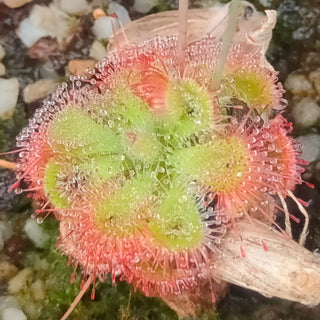Rubus occidentalis
BLACK RASPBERRY, BLACK CAP
- Unit price
- / per
Rubus occidentalis is native to eastern North America. Its common name black raspberry is shared with other closely related species. Other names occasionally used include bear's eye blackberry, black cap, black cap raspberry, and scotch cap.
Rubus occidentalis is a deciduous shrub growing to 2 to 3 metres (6.6 to 9.8 ft) tall. The round-shaped fruit is a 12-to-15-millimetre (0.47 to 0.59 in) diameter aggregation of drupelets; it is edible, and has a high content of anthocyanins and ellagic acid.
The black raspberry is related to the red raspberry Rubus idaeus and Rubus strigosus, sharing the white underside of leaves, and fruit that readily detaches from the carpel.
The plant grows in disturbed areas, especially those that are logged or cut. It is also found in meadows, and near streams and lakes, trails or roadways. The native range of Rubus occidentalis extends as far east as New Brunswick, as far west as Nebraska, as far north as Quebec, and as far south as Mississippi.
The fresh berries are marketed in season. The berries are often dried or frozen, made into pur??es and juices, or processed as colorants. Two well-known liqueurs based predominantly on black raspberry fruit include France's Chambord Liqueur Royale de France and South Korea's various kinds of Bokbunja-ju.
Type: Hardy shrub
Location: Sun or part sun
Hardiness zones: 3-8
Seeds per packet: 10
Soak the seeds for 12-24 hours before planting. Sow just under the surface of the soil and water in. Then cover them with plastic and place in a fridge for 90 days. Be sure they stay moist. After the cold stratification period they are then brought back to room temperature 20-22C (68-72F) for them to germinate. Germination is generally 30-90 days after the warming period, though some can take longer. Do not discard the planting tray, as patience is needed, and they are well worth the wait.
Rubus occidentalis
BLACK RASPBERRY, BLACK CAP
- Unit price
- / per
Multiple secure payment options available.
Adding product to your cart
You may also like
Rubus occidentalis is native to eastern North America. Its common name black raspberry is shared with other closely related species. Other names occasionally used include bear's eye blackberry, black cap, black cap raspberry, and scotch cap.
Rubus occidentalis is a deciduous shrub growing to 2 to 3 metres (6.6 to 9.8 ft) tall. The round-shaped fruit is a 12-to-15-millimetre (0.47 to 0.59 in) diameter aggregation of drupelets; it is edible, and has a high content of anthocyanins and ellagic acid.
The black raspberry is related to the red raspberry Rubus idaeus and Rubus strigosus, sharing the white underside of leaves, and fruit that readily detaches from the carpel.
The plant grows in disturbed areas, especially those that are logged or cut. It is also found in meadows, and near streams and lakes, trails or roadways. The native range of Rubus occidentalis extends as far east as New Brunswick, as far west as Nebraska, as far north as Quebec, and as far south as Mississippi.
The fresh berries are marketed in season. The berries are often dried or frozen, made into pur??es and juices, or processed as colorants. Two well-known liqueurs based predominantly on black raspberry fruit include France's Chambord Liqueur Royale de France and South Korea's various kinds of Bokbunja-ju.
Type: Hardy shrub
Location: Sun or part sun
Hardiness zones: 3-8
Seeds per packet: 10
Soak the seeds for 12-24 hours before planting. Sow just under the surface of the soil and water in. Then cover them with plastic and place in a fridge for 90 days. Be sure they stay moist. After the cold stratification period they are then brought back to room temperature 20-22C (68-72F) for them to germinate. Germination is generally 30-90 days after the warming period, though some can take longer. Do not discard the planting tray, as patience is needed, and they are well worth the wait.
















































